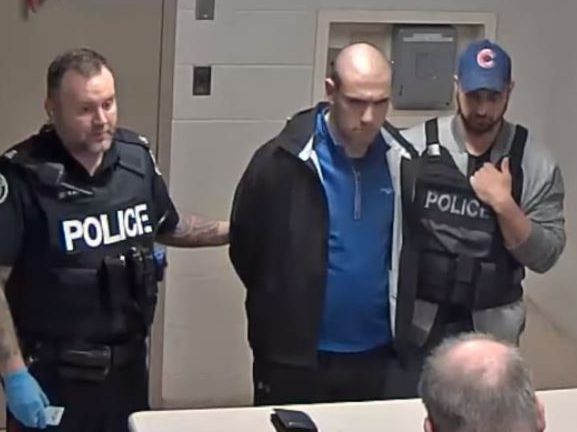BREAKING: Alek Minassian found criminally responsible for Toronto van attack
Author of the article:Michele Mandel
Publishing date:Mar 03, 2021 • 17 minutes ago • 3 minute read • comment bubble29 Comments
Alek Minassian is booked at 32 Division after the April 23, 2018 van attack in Toronto
Alek Minassian is booked at 32 Division after the April 23, 2018 van attack in Toronto PHOTO BY SCREENGRAB /Toronto Police
Article content
He is a convicted mass murderer.
Alek Minassian has been found guilty of 10 counts of first-degree murder and 16 of attempted murder in a highly awaited decision delivered over YouTube Wednesday morning.
Ontario Superior Court Justice Anne Molloy said Minassian, 28, had not established on a balance of probabilities that he should be found not criminally responsible of the horrific 2018 Yonge St. van attack due to his autism spectrum disorder.
In an unusual move, the judge refused to utter his name during her decision, choosing to call him “John Doe” because she wanted to deny him the infamy he sought. And in future, she said we should carefully consider withholding the names of perpetrators in similar cases.
In excerpts that she read from her 68-page decision, Molloy said autism spectrum disorder is eligible to be considered as a mental disorder for a possible defence under the not criminally responsible section. But Minassian’s ASD did not prevent him from making a rational choice that he knew was morally wrong.
Advertisement
STORY CONTINUES BELOW
This advertisement has not loaded yet, but your article continues below.
Article content
Toronto Police at the scene of the arrest of the accused van driver Alek Minassian on Poyntz Ave., April 23, 2018.
Toronto Police at the scene of the arrest of the accused van driver Alek Minassian on Poyntz Ave., April 23, 2018.
“It is clear to me that Mr. Doe knew that his actions would be seen by a vast majority of society as morally wrong,” she said. “Mr. Doe thought about committing these crimes over a considerable period of time and made a considered decision to proceed.
“His attack on these 26 victims that day was an act of a reasoning mind not withstanding its horrific nature and notwithstanding he has no remorse for it and no empathy for his victims.”
WHAT MADE HIM KILL
The victims were Anne Marie D’Amico, 30, Dorothy Sewell, 80, Renuka Amarasingha, 45, Munir Najjar, 85, Chul Min (Eddie) Kang, 45, Mary Elizabeth (Betty) Forsyth, 94, Sohe Chung, 22, Andrea Bradden, 33, Geraldine Brady, 83, and Ji Hun Kim, 22.
Minassian had been fantasizing about mass murder for over a decade and believed this was his way of becoming infamous.
“In this case, Mr. Doe knew it was legally wrong to kill people and he also knew his plan to run down and kill people constituted first-degree murder and that if arrested, he would go to jail for the rest of his life,” she said.
“That is why his plan was death by cop, that being preferable to jail. Mr. Doe knew that the vast majority of people in society would find an act of mass murder to be morally wrong. However, he wanted to achieve fame and notoriety.”
Toronto Police Const. Ken Lam arrests Toronto van attack driver Alek Minassian on April 23, 2018.
Toronto Police Const. Ken Lam arrests Toronto van attack driver Alek Minassian on April 23, 2018. PHOTO BY SCREENGRAB
He saw himself as a failure with no hope for the future and didn’t care if he died as long as he died achieving fame.
He considered the impact it would have on his family but deliberately set those concerns aside because he didn’t want them to prevent him from achieving his goal.
“He was capable of understanding the impact it would have on his victims. He knew death would be irreversible. He knew their families would grieve,” she said.
MORE ON THIS TOPIC
Toronto Police are seen near a damaged van in Toronto after a rental van hit pedestrians along Yonge St. on April 23, 2018. (CP)
MANDEL: Not criminally responsible? Toronto van killer to learn verdict
Alek Minassian is booked at 32 Division after the April 23, 2018 van attack in Toronto
MANDEL: Will this be mass killer Alek Minassian's last Christmas behind bars?
Alek Minassian is accused of murdering 10 people and wounding 16 others in a van attack on Yonge St. in Toronto.
MANDEL: Blame Minassian's autism for 'horrific' mass killing, lawyer insists
At various times, he described his actions as “devastating, despicable, shocking, morally terrible, a horrible thing and irredeemable.”
He had a functioning rational brain and knew it was morally wrong. “He then made a choice. He chose to commit the crimes anyway,” she said.
READ THE VERDICT
Advertisement
STORY CONTINUES BELOW
This advertisement has not loaded yet, but your article continues below.
Article content
mmandel@postmedia.com

 dynamic.postmedia.com
dynamic.postmedia.com

 scribd.com
scribd.com

 torontosun.com
torontosun.com
Author of the article:Michele Mandel
Publishing date:Mar 03, 2021 • 17 minutes ago • 3 minute read • comment bubble29 Comments
Alek Minassian is booked at 32 Division after the April 23, 2018 van attack in Toronto
Alek Minassian is booked at 32 Division after the April 23, 2018 van attack in Toronto PHOTO BY SCREENGRAB /Toronto Police
Article content
He is a convicted mass murderer.
Alek Minassian has been found guilty of 10 counts of first-degree murder and 16 of attempted murder in a highly awaited decision delivered over YouTube Wednesday morning.
Ontario Superior Court Justice Anne Molloy said Minassian, 28, had not established on a balance of probabilities that he should be found not criminally responsible of the horrific 2018 Yonge St. van attack due to his autism spectrum disorder.
In an unusual move, the judge refused to utter his name during her decision, choosing to call him “John Doe” because she wanted to deny him the infamy he sought. And in future, she said we should carefully consider withholding the names of perpetrators in similar cases.
In excerpts that she read from her 68-page decision, Molloy said autism spectrum disorder is eligible to be considered as a mental disorder for a possible defence under the not criminally responsible section. But Minassian’s ASD did not prevent him from making a rational choice that he knew was morally wrong.
Advertisement
STORY CONTINUES BELOW
This advertisement has not loaded yet, but your article continues below.
Article content
Toronto Police at the scene of the arrest of the accused van driver Alek Minassian on Poyntz Ave., April 23, 2018.
Toronto Police at the scene of the arrest of the accused van driver Alek Minassian on Poyntz Ave., April 23, 2018.
“It is clear to me that Mr. Doe knew that his actions would be seen by a vast majority of society as morally wrong,” she said. “Mr. Doe thought about committing these crimes over a considerable period of time and made a considered decision to proceed.
“His attack on these 26 victims that day was an act of a reasoning mind not withstanding its horrific nature and notwithstanding he has no remorse for it and no empathy for his victims.”
WHAT MADE HIM KILL
The victims were Anne Marie D’Amico, 30, Dorothy Sewell, 80, Renuka Amarasingha, 45, Munir Najjar, 85, Chul Min (Eddie) Kang, 45, Mary Elizabeth (Betty) Forsyth, 94, Sohe Chung, 22, Andrea Bradden, 33, Geraldine Brady, 83, and Ji Hun Kim, 22.
Minassian had been fantasizing about mass murder for over a decade and believed this was his way of becoming infamous.
“In this case, Mr. Doe knew it was legally wrong to kill people and he also knew his plan to run down and kill people constituted first-degree murder and that if arrested, he would go to jail for the rest of his life,” she said.
“That is why his plan was death by cop, that being preferable to jail. Mr. Doe knew that the vast majority of people in society would find an act of mass murder to be morally wrong. However, he wanted to achieve fame and notoriety.”
Toronto Police Const. Ken Lam arrests Toronto van attack driver Alek Minassian on April 23, 2018.
Toronto Police Const. Ken Lam arrests Toronto van attack driver Alek Minassian on April 23, 2018. PHOTO BY SCREENGRAB
He saw himself as a failure with no hope for the future and didn’t care if he died as long as he died achieving fame.
He considered the impact it would have on his family but deliberately set those concerns aside because he didn’t want them to prevent him from achieving his goal.
“He was capable of understanding the impact it would have on his victims. He knew death would be irreversible. He knew their families would grieve,” she said.
Toronto Police are seen near a damaged van in Toronto after a rental van hit pedestrians along Yonge St. on April 23, 2018. (CP)
MANDEL: Not criminally responsible? Toronto van killer to learn verdict
Alek Minassian is booked at 32 Division after the April 23, 2018 van attack in Toronto
MANDEL: Will this be mass killer Alek Minassian's last Christmas behind bars?
Alek Minassian is accused of murdering 10 people and wounding 16 others in a van attack on Yonge St. in Toronto.
MANDEL: Blame Minassian's autism for 'horrific' mass killing, lawyer insists
At various times, he described his actions as “devastating, despicable, shocking, morally terrible, a horrible thing and irredeemable.”
He had a functioning rational brain and knew it was morally wrong. “He then made a choice. He chose to commit the crimes anyway,” she said.
READ THE VERDICT
Advertisement
STORY CONTINUES BELOW
This advertisement has not loaded yet, but your article continues below.
Article content
mmandel@postmedia.com

Toronto Van Attack: Inside the mind of a killer | Toronto Sun
After coolly confessing to running down 26 people and killing 10 of them on Yonge St., he's disappointed that he had to end his murderous rampage too soon.
Alex Minassian Verdict | PDF | Insanity Defense | Autism Spectrum
Justice Anne Molloy's Reasons for Judgment in the case of the Toronto van attack

MANDEL: Toronto's mass murderer who shall not be named
Know their names. The names that matter.



